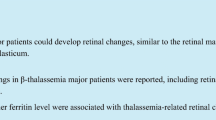Abstract
Objectives
To determine the association of ocular manifestations in beta-thalassemia with the patient’s age, blood transfusion requirements, average serum ferritin and dose and duration of iron chelation therapy.
Methods
Sixty multi-transfused beta thalassemia patients of 12 to 18 y of age on chelation therapy were included in this cross-sectional analysis. Structural and functional evaluation of the retina was done using Optical coherence tomography (OCT) and Electroretinography (ERG), including flash ERG and Pattern ERG (PERG). Routine ophthalmic examination and B scan of the eye was also done. Flash ERG a-waves and b-waves were recorded, however only a-wave amplitude was evaluated. Pattern ERG n35, n95 and p50 waves were recorded and p50 wave amplitude was evaluated. The a-wave on flash and p50 on pattern waves represent retinal photoreceptor epithelium (RPE) photoreceptor response, which is mainly affected in beta-thalassemia.
Results
Ocular changes were detected in 38.3% and a significant correlation was noted with increase in age (p = 0.045) but not with serum ferritin, transfusion requirements or chelation therapy. Refractive errors were found in 14 cases (23%), such as myopia with astigmatism in 13 (21.7%) and only myopia in 6 subjects (10%). OCT abnormality was noted in 1 patient (1.7%) who had thinning of central retina; right eye 132 μm and left eye 146 μm (n > 200 μm). Abnormalities were noted in a-wave amplitude on flash ERG in 20% of cases, while reduced p50 amplitude on PERG was noted in 15%.
Conclusions
A significant correlation was noted between ocular findings and increase in age, but not with serum ferritin, transfusion requirements or chelation therapy. ERG appears to be a promising tool for screening patients with beta-thalassemia and can serve as a follow-up test for evaluating retinal function.


Similar content being viewed by others
References
Grow K, Vashist M, Abrol P, Sharma S, Yadav R. Beta thalassemia in India: current status and the challenges ahead. Int J Pharm Pharm Sci. 2014;6:28–33.
Rund D, Rachmilewitz E. Beta-thalassemia. N Engl J Med. 2005;353:1135–46.
Forget BG. The pathophysiology and molecular genetics of beta thalassemia. Mt Sinai J Med. 1993;60:95–103.
Porter JB, Davis BA. Monitoring chelation therapy to achieve optimal outcome in the treatment of thalassaemia. Best Pract Res Clin Haematol. 2002;15:329–48.
Chen H, Lukas T, Du N, Suyeoka G, Neufeld A. Dysfunction of the retinal pigment epithelium with age: increased iron decreases phagocytosis and lysosomal activity. Invest Ophthalmol Vis Sci. 2009;50:1895–902.
Hadziahmetovic M, Song Y, Wolkow N, et al. The oral iron chelator deferiprone protects against iron overload–induced retinal degeneration. Invest Ophthalmol Vis Sci. 2011;52:959–68.
Di Nicola M, Giulio B, Dell’Arti L, Ratiglia R, Viola F. Functional and structural abnormalities in deferoxamine retinopathy: a review of the literature. Bio Med Res Int. 2015;2015:1–12.
Masera N, Rescaldani C, Azzolini M, et al. Development of lens opacities with peculiar characteristics in patients affected by thalassemia major on chelating treatment with deferasirox (ICL670) at the pediatric Clinic in Monza, Italy. Haematologica. 2008;93:e9–10.
Wong RW, Richa DC, Hahn P, Green WR, Dunaief JL. Iron toxicity as a potential factor, in AMD. Retina. 2007;27:997–1003.
Malak DSM, Dabbous OAE, Saif MYS, Saif ATS. Ocular manifestations in children with B thalassemia major and visual toxicity of iron chelating agents. J Am Sci. 2012;8:633–8.
Gaba A, Souza PD, Chandra J, Narayan S, Sen S. Ocular abnormalities in patients with beta thalassemia. Am J Opthalmol. 1998;108:699–703.
Taneja R, Malik P, Sharma M, Agarwal MC. Multiple transfused thalassemia major: ocular manifestations in a hospital-based population. Indian J Ophthalmol. 2010;58:125–30.
Taher A, Bashshur Z, Shamseddeen WA, et al. Ocular findings among thalassemia patients. Am J Ophthalmol. 2006;142:704–5.
Rohul J, Maqbool A, Hussain SA, Shamila H, Anjum F, Hamdani ZA. Prevalence of refractive errors in adolescents in out- patient attendees of the preventive ophthalmology clinic of community medicine, S K I M S, Kashmir. India Nitte Uni J Health Sci. 2013;3:17–20.
Gartaganis SP, Zoumbos N, Koliopoulos JX, Mela EK. Contrast sensitivity function in patients with beta-thalassemia major. Acta Ophthalmol Scand. 2000;78:512–5.
Dewan P, Gomber S, Chawla H, Rohatgi J. Ocular changes in multi-transfused children with β-thalassaemia receiving desferrioxamine: a case-control study. South Afr J Child Health. 2011;5:11–4.
Eleftheriadou M, Theodossiadis P, Rouvas A, Alonistiotis D, Theodossiadis G. New optical coherence tomography fundus findings in a case of beta-thalassemia. Clin Ophthalmol. 2012;6:2119–22.
Jalali S, Holder GE, Ram LSM, Vedantam V. Visual Electrophysiology in the Clinic: A Basic Guide to Recording and Interpretation. CME Series, no. 17. New Delhi: All India Ophthalmological Society; 2015. p. 1–8.
Ishizaka N, Saito K, Mitani H, et al. Iron overload augments angiotensin II-induced cardiac fibrosis and promotes neointima formation. Circulation. 2002;106:1840–6.
Cunningham MJ, Macklin EA, Neufeld EJ. Cohen AR; thalassemia clinical research network. Complications of beta-thalassemia major in North America. Blood. 2004;104:34–9.
Acknowledgements
The authors would like to thank the children with thalassemia who shared their information.
Contributions
HP: Collected data and drafted the manuscript; RHM: Revised and prepared the manuscript, supervised the study and will act as guarantor of the study; NT and DB: Ophthalmic evaluation.
Author information
Authors and Affiliations
Corresponding author
Ethics declarations
Conflict of Interest
None.
Source of Funding
None.
Rights and permissions
About this article
Cite this article
Merchant, R.H., Punde, H., Thacker, N. et al. Ophthalmic Evaluation in Beta-Thalassemia. Indian J Pediatr 84, 509–514 (2017). https://doi.org/10.1007/s12098-017-2339-8
Received:
Accepted:
Published:
Issue Date:
DOI: https://doi.org/10.1007/s12098-017-2339-8




